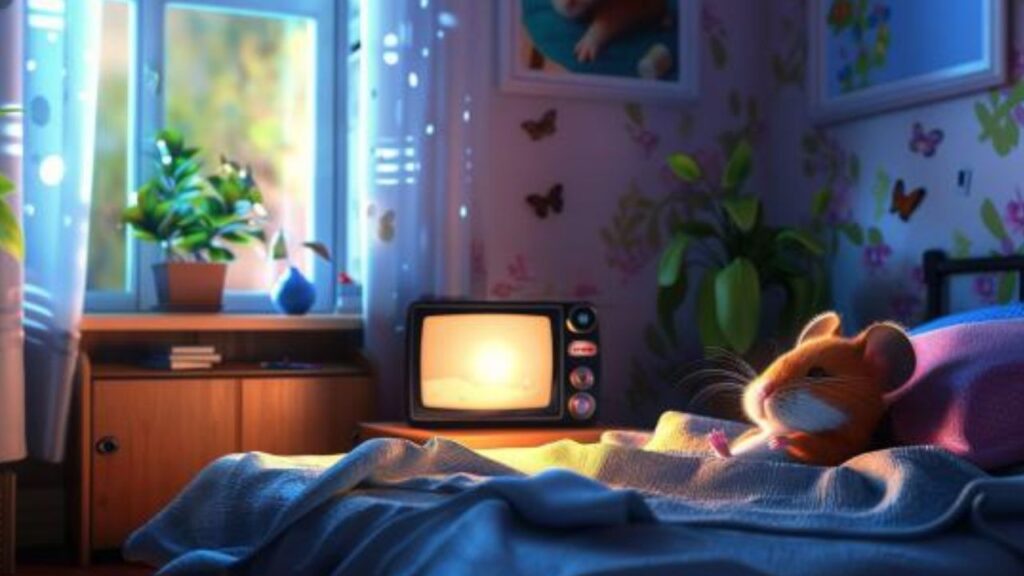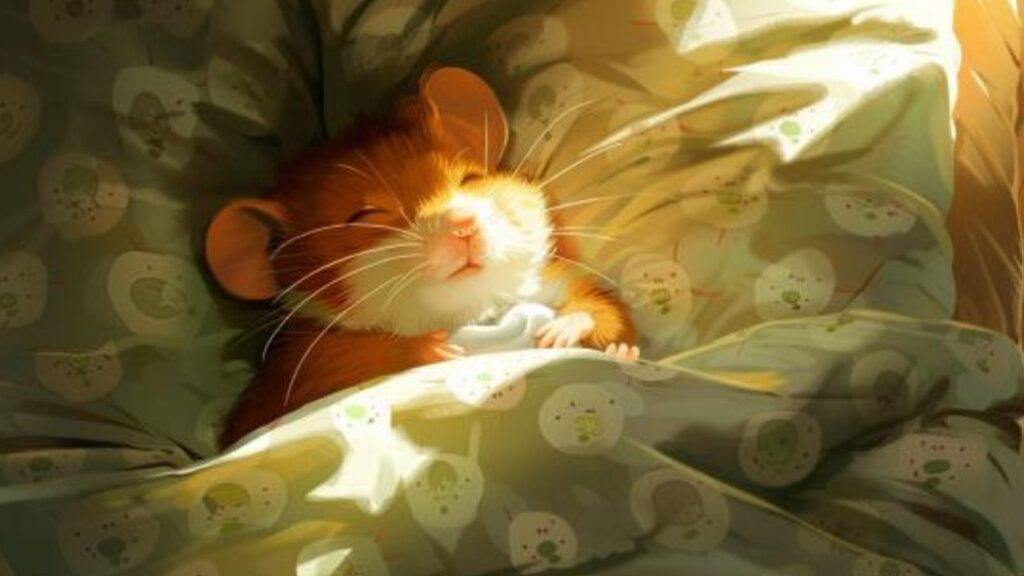Hello, fellow hamster enthusiasts! Dr. Vivian Whiskerson here, your guide to all things small and furry. Today, we’re diving into the soft, fluffy world of hamster sleeping quarters. Creating a cozy nook for your furry friend isn’t just about aesthetics; it’s essential for their health and happiness. Let’s burrow into the importance of crafting the perfect naptime nooks for our whiskered companions.
Why Sleep Matters for Hamsters
Much like us, hamsters require a good night’s… well, day’s sleep, to maintain their health and wellbeing. Sleep supports their immune system, aids in digestion, and helps with overall mood stability. A well-rested hamster is a happy, active, and friendly pet. Conversely, a lack of secluded, comfortable sleeping quarters can lead to stress, irritability, and health issues for your furry friend.
Understanding Hamster Sleep Patterns
Hamsters are nocturnal (or, more accurately, crepuscular) creatures, meaning they’re most active at dawn and dusk. During the day, they seek refuge in a quiet, dark place to get their much-needed rest. Unlike humans, hamsters experience polyphasic sleep cycles, meaning they sleep in multiple short bursts throughout their resting period. This unique pattern underscores the necessity of a permanent, peaceful retreat in their cage.
The Role of a Comfortable Sleeping Quarter
A cozy sleeping quarter does more than just provide a place for your hamster to rest. It also offers a sense of security and safety, mimicking the burrows they would naturally create in the wild. This safe haven is crucial for your pet’s mental health, helping to prevent anxiety and stress. Additionally, a dedicated sleeping area helps to establish a routine, encouraging healthy sleep patterns that are vital for your hamster’s overall health.
Choosing the Right Location and Enclosure

When it comes to ensuring your hamster has the perfect naptime nook, the location of their enclosure within your home and the cage itself play pivotal roles. As Dr. Vivian Whiskerson, I’m here to guide you through selecting the optimal spot for your hamster’s home and how to set it up for supreme snoozing. Let’s get started!
Selecting the Best Spot in Your Home
- Temperature and Lighting. Hamsters thrive in environments that maintain a consistent temperature, ideally between 65°F and 75°F (18°C to 24°C). Extreme temperatures can disrupt their sleep patterns and overall health. Equally important is the lighting. Since hamsters are most active during dawn and dusk, they require a space that mimics this natural light cycle. Placing their cage in a room that receives natural light but is not directly exposed to sunlight for prolonged periods is ideal. This setup helps mimic their natural living conditions, promoting healthier sleep cycles.
- Noise Levels. Your furry friend’s naptime nook should be in a low-traffic area to minimize disturbances. Hamsters have sensitive hearing and can easily be startled by loud noises, which can disrupt their sleep and lead to stress. A quiet room where the hustle and bustle of daily life won’t constantly awaken them is best.
- Safety and Accessibility. Consider placing the cage in a room that’s safe from other pets and potential hazards. Additionally, the location should be easily accessible for you to perform daily care routines without causing much disturbance.
The Ideal Cage for Sleep
- Size Matters. A spacious cage is essential for your hamster’s overall wellbeing, including their sleep health. The minimum recommended size is 450 square inches of continuous floor space, but bigger is always better. A larger cage allows for a distinct sleeping area, separate from their exercise and bathroom areas, which is crucial for cleanliness and comfort.
- Type of Enclosure. Wire cages offer great ventilation, but the bars can sometimes be a source of injury or escape. Aquariums or terrariums provide a good alternative, offering ample viewing opportunities without the risk of escape or injury, but they require careful attention to ventilation. Modular plastic cages can be fun and engaging for your pet but ensure they have enough ventilation and space for a dedicated sleeping area.
- Ventilation. Good airflow is crucial for preventing the buildup of ammonia from urine and ensuring your hamster’s sleeping quarters remain fresh. However, drafts should be avoided as they can cause health issues.
Safe Materials and Setup
- Bedding. Soft, absorbent, and dust-free bedding is vital for a comfortable sleep area. Paper-based or aspen bedding is recommended, as some materials like cedar or pine shavings can be harmful due to their aromatic oils. The bedding should be deep enough for your hamster to burrow into, as this mimics their natural behavior and provides a sense of security.
- Hideouts. A hideout or sleeping house is a must-have in any hamster cage. It should be made of safe, chewable materials like untreated wood or edible cardboard. The hideout gives your hamster a private place to sleep and nest, which is essential for their well-being.
- Chew Toys.While not directly related to sleep, providing chew toys in the cage can help keep your hamster’s teeth in good condition, preventing potential discomfort that could disrupt their sleep. Ensure these are made from safe, non-toxic materials.
Selecting the right location and enclosure for your hamster’s naptime nook is a step towards ensuring their happiness and health. With the proper setup, your furry friend will have a cozy retreat to rest and recharge, ready for their next nocturnal adventure.
Essential Features of a Hamster Naptime Nook

Creating a serene naptime nook for your hamster involves more than just a quiet corner and a hideout. As a dedicated hamster caretaker and enthusiast, I, Dr. Vivian Whiskerson, am here to guide you through the intricacies of setting up an ideal resting place that caters to your furry friend’s needs for comfort, security, and environmental control. Let’s explore the essential features that will make your hamster’s sleeping quarters a dreamy escape.
Soft Bedding Options
- Choosing the Right Material. The foundation of a comfortable naptime nook is the bedding. Soft, absorbent, and safe bedding materials are paramount. Paper-based bedding is highly recommended due to its softness, absorbency, and low dust, which is gentle on hamsters’ respiratory systems. Aspen shavings are another safe alternative, offering a natural and comfortable solution. Remember, the bedding should be free from chemicals and inks, ensuring it’s safe for your hamster to burrow into and, inevitably, nibble on.
- Depth for Burrowing. Hamsters have a natural instinct to burrow, which provides them with a sense of security and privacy. Providing a deep layer of bedding—at least 2-3 inches—allows them to dig and create their own cozy nest within their enclosure. This not only satisfies their burrowing instinct but also contributes to their overall well-being and comfort.
Privacy and Security Needs
- Hideouts and Shelters. A hideout is crucial for your hamster’s naptime nook, offering a secluded spot where they can feel safe and undisturbed. Wooden hideouts or those made from safe, edible materials are ideal, as they provide an added chewing opportunity. The hideout should be spacious enough for your hamster to move comfortably but cozy enough to offer a sense of security.
- Placement Within the Cage. The placement of the hideout within the cage can further enhance your hamster’s sense of privacy and security. Positioning it in a quieter, more sheltered part of the cage, away from the feeding and exercise areas, can help create a distinct resting space. Ensuring there’s ample bedding around and inside the hideout will also make it more inviting.
Temperature and Lighting Considerations
- Maintaining Optimal Temperature. Hamsters are sensitive to temperature changes, and their sleeping quarters should be kept at a comfortable range between 65°F and 75°F (18°C to 24°C). Avoid placing the cage near radiators, windows, or air conditioning units, as direct sunlight or drafts can cause significant temperature fluctuations that disrupt their comfort and health.
- Lighting for a Natural Cycle. Mimicking natural light cycles is essential for your hamster’s sleep health. While direct sunlight should be avoided to prevent overheating, natural light patterns help regulate their sleep cycles. However, during their active hours at dawn and dusk, dim lighting can help simulate twilight conditions, making it easier for them to transition between sleeping and waking periods.
Accessorizing for Comfort and Enrichment

Creating a comfortable and enriching environment for your hamster isn’t just about meeting their basic needs; it’s about enhancing their quality of life and ensuring they feel secure and stimulated, even in their sleeping quarters. As Dr. Vivian Whiskerson, I’m here to guide you through accessorizing your hamster’s naptime nook with cozy sleep accessories, ensuring adequate ventilation, and emphasizing the importance of cleanliness and maintenance. Let’s make your hamster’s dreams even sweeter!
Adding Cozy Sleep Accessories
- Nest Materials. Providing materials for nesting is a wonderful way to enhance your hamster’s sleeping quarters. Unscented toilet paper or facial tissue can be added to the enclosure for your hamster to shred and arrange as they see fit. These materials allow them to engage in natural nesting behaviors, creating a snug and warm bed that’s customized to their preference.
- Soft Blankets or Sleep Pads. While not necessary, a soft, small blanket or a sleep pad designed for small animals can add an extra layer of comfort to your hamster’s hideout. Ensure any fabric used is safe and non-toxic, with no loose threads or small parts that could be ingested or cause entanglement.
- Comfort Toys. Sometimes, a small, soft toy can provide comfort, especially for hamsters that are solitary or newly adopted and may feel anxious. Ensure the toy is safe for hamsters, without parts that could be chewed off and swallowed.
Ensuring Adequate Ventilation
- Airflow is Key. Proper ventilation in your hamster’s sleeping quarters is crucial for maintaining fresh air and preventing the buildup of harmful ammonia from urine. Even if your hamster’s enclosure is in a spot with good air quality, ensuring the cage itself has adequate ventilation is essential. This can be achieved through a wire cage with appropriate spacing (but not too wide to escape) or an aquarium with a mesh top.
- Avoiding Drafts. While ventilation is important, placing the cage in an area free from drafts ensures that your hamster isn’t exposed to sudden temperature changes that can lead to respiratory issues or discomfort.
The Importance of Cleanliness and Maintenance
- Regular Cleaning Schedule. Maintaining cleanliness in your hamster’s naptime nook is paramount for their health and comfort. A regular cleaning schedule, including daily spot checks for soiled bedding and weekly full cage cleanings, will keep their environment healthy and odor-free. Always replace old bedding with fresh material during cleaning to ensure a clean and comfortable resting space.
- Monitoring for Pests. Part of maintenance includes monitoring for pests, such as mites, which can infiltrate bedding and cause discomfort or health issues for your hamster. Regularly check your pet and their bedding for any signs of infestation, and take immediate action if needed.
- Refresh Accessories. Regularly inspect and refresh sleep accessories as needed. Nesting materials should be replenished, and any worn or damaged items should be replaced to ensure your hamster’s environment remains inviting and secure.
Tips for a Blissful Hamster Nap

Creating a comfortable and enriching environment for your hamster not only promotes better sleep but also enhances their overall quality of life. I, Dr. Vivian Whiskerson, am here to share some “Whisker Tips” that will ensure your furry friend enjoys many blissful naps. Let’s delve into the best practices for maintaining an ideal sleeping environment, from cleanliness to adapting to different seasons.
Regular Cleaning Schedule
Why Cleanliness Matters. A clean habitat is crucial for your hamster’s health and well-being. Accumulated waste and soiled bedding can lead to unpleasant odors, attract pests, and foster the growth of harmful bacteria, all of which can disturb your hamster’s sleep and potentially cause health issues.
How to Maintain a Clean Naptime Nook
- Daily Spot Cleaning: Every day, remove soiled bedding, uneaten food, and waste. This routine helps keep the environment fresh and prevents the buildup of harmful substances.
- Weekly Deep Cleaning: Once a week, conduct a more thorough cleaning. This involves replacing all bedding, washing the cage with pet-safe disinfectant, and rinsing all accessories, including hideouts and chew toys. Ensuring the cage is completely dry before reintroducing your hamster and new bedding prevents mold and bacteria growth.
Monitoring Your Hamster’s Sleep Habits
Observing Sleep Patterns. Regularly observing your hamster’s sleep patterns can provide valuable insights into their health and happiness. Sudden changes, such as sleeping more or less than usual, can be early indicators of stress, discomfort, or illness.
What to Look For
- Consistency in Sleep Schedule: While hamsters are nocturnal, they should have a relatively consistent sleep schedule. Dramatic changes may warrant a vet visit.
- Quality of Sleep: Ensure your hamster is sleeping peacefully without frequent awakenings. Disturbed sleep can be a sign of environmental stressors or health issues.
Adapting the Environment for Seasons and Health
- Seasonal Adjustments. The changing seasons can affect your hamster’s comfort and sleep quality. In warmer months, ensure adequate ventilation and consider a cooler room within the safe temperature range. During colder months, avoid drafts and ensure the sleeping area is sufficiently insulated without overheating.
- Health Considerations. If your hamster is showing signs of illness or discomfort, adapting their environment can aid their recovery. For example, additional soft bedding can provide support for older hamsters with arthritis, while ensuring the cage is easily navigable for hamsters with sight or mobility issues.
Conclusion: The Joy of Watching Your Hamster Snooze Peacefully

As we’ve burrowed through the ins and outs of creating the perfect naptime nook for our furry friends, it’s clear that the effort invested in providing a comfortable and safe environment for your hamster reaps its own rewards. I, Dr. Vivian Whiskerson, have cherished guiding you through this process, highlighting the importance of sleep for your hamster’s health and happiness. Let’s reflect on the joys and benefits of watching your hamster snooze peacefully in their well-crafted naptime nook.
The Rewards of Providing a Perfect Naptime Nook
Creating an ideal sleeping quarter for your hamster is more than just a task—it’s an expression of love and care for your tiny companion. The satisfaction of seeing your hamster curl up and drift into a peaceful sleep in a habitat you’ve thoughtfully prepared is immeasurable. It’s a tangible sign that they feel safe, secure, and comfortable in their home, which in turn, fosters a deeper bond between you and your pet.
Encouraging Natural Behaviors
A well-designed naptime nook does more than ensure restful sleep; it encourages your hamster to engage in natural behaviors. From burrowing into soft bedding to nest-building within a cozy hideout, these activities are essential for your hamster’s physical and mental well-being. Providing the right conditions for these behaviors not only ensures a happier hamster but also offers you the delight of observing your pet express their innate instincts in the safety and comfort of their enclosure.
A Final Thought: A Happy Hamster is a Wheel-y Happy You!
The journey to creating the perfect naptime nook for your hamster is a rewarding experience that enhances the well-being of your beloved pet. It’s a testament to the care and attention you’re willing to invest in ensuring their happiness and comfort. Watching your hamster snooze peacefully is a heartwarming reward, a reminder of the simple joys in life, and the special bond you share with your pet.
As we conclude this guide, remember that the care you put into every aspect of your hamster’s life—from their sleeping quarters to their daily exercise—contributes to their overall happiness and health. A happy, well-rested hamster is more active, engaging, and affectionate, enriching your life in countless, unexpected ways. So, as you continue on your journey as a hamster caretaker, keep in mind that a happy hamster truly does make for a wheel-y happy you!




